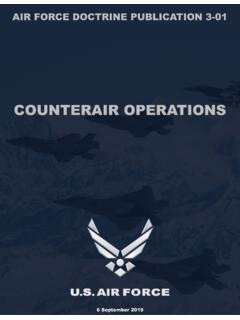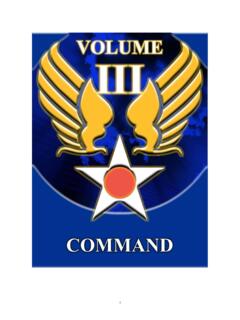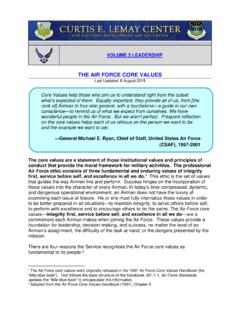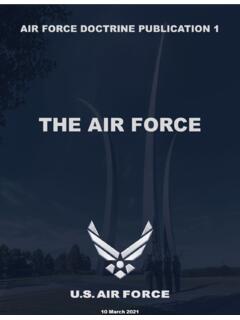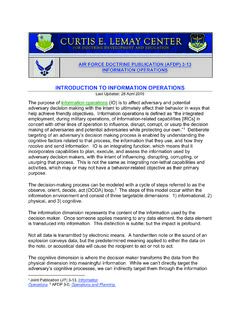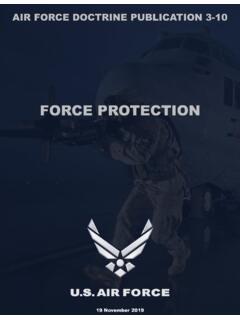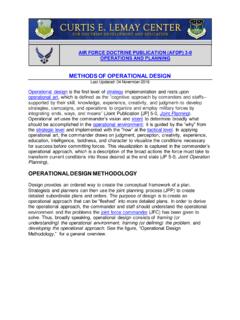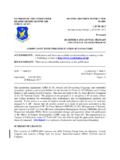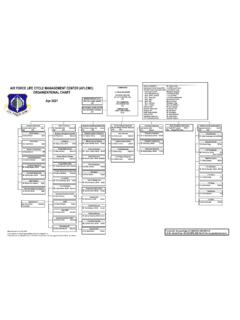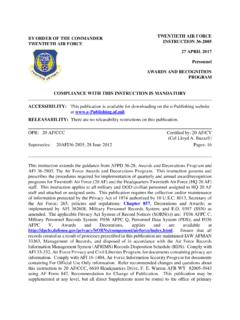Transcription of THE JOINT PLANNING PROCESS FOR AIR - AF
1 THE JOINT PLANNING PROCESS FOR AIR Last Updated: 04 November 2016 The air force creates plans for contingencies and other operations using the PROCESS known as the JOINT PLANNING PROCESS for air (JPPA). The JPPA is a seven-step PROCESS that essentially recapitulates the JOINT PLANNING PROCESS (JPP) at the component level. It culminates in the production of the JOINT air operations plan (JAOP) or a Service component plan, as well as supporting plans and orders. The JPPA is the PROCESS by which commanders, air force forces (COMAFFORs) and their staffs create the detailed plans they require to effectively employ airpower, including the JAOP, operation orders (OPORDs), and others. Since the COMAFFOR is normally also the JOINT force air component commander (JFACC), the JPPA is also the JOINT force air component s equivalent of the JOINT force commander s (JFC s) JPP and can be performed in parallel with it. If the COMAFFOR anticipates the need for such PLANNING , he or she may direct preparations before formal tasking is received.
2 The JPPA produces the JAOP and the COMAFFOR s component plan, and, as part of an ongoing battle rhythm, the guidance JOINT PLANNING Processes AIR F ORCE DOCTRINE PUBLICATION (AFDP) 3-0 OPERA TIONS AND PLANNING that helps create the air operations directive, which guides the tasking cycle through its iterative execution. The JPPA may also be used to produce required supporting plans and concepts, such as a long-range phased air targeting scheme (PATS), an area air defense plan, an airspace control plan, operation orders required by the COMAFFOR s staff, and others. The JPP and JPPA consist of seven steps each, as depicted in the figure, JOINT Operation PLANNING Processes. Each of the stages is discussed below. The component s senior strategists and other select members of the staff should interact frequently with their counterparts on the JFC s staff, to develop mutual professional confidence. These habitual relationships facilitate air strategists being asked to join the JFC s JOINT PLANNING group (JPG) (or like body) to help create the JFC s operation plan and operation order (and other plans and orders, as required).
3 They should review currently available forces and determine what, if any, additional forces or capabilities may be required and where all forces should be located. When these strategists return to the air operations center s (AOC s) strategy division (SRD) and strategy plans team, they should then repeat the PROCESS , as the JPPA, for their component command, producing the JAOP and the COMAFFOR s component plan. If they have secure means prior to departing JFC s JPG, they may also communicate PLANNING requirements directly to appropriately cleared planners at the AOC, in order to begin time-consuming preparations at once. Inside the AOC, the SRD staff often leads operational-level PLANNING , but is supported by other COMAFFOR and AOC staff elements. INITIATION PLANNING begins when an appropriate authority recognizes a potential need to employ military capabilities in response to a probable or actual crisis and initiates strategy development and operational design.
4 At the strategic level, the initiating authority is national leadership the President, Secretary of Defense, and Chairman of the JOINT Chiefs of Staff. Below the national strategic level, that authority is usually a JFC (combatant commander [CCDR] or JOINT task force commander ). Formal tasking is usually communicated through a PLANNING order. At any level, however, a commander may deem it prudent to begin PLANNING for a contingency when, in the commander s judgment, the situation warrants it. Airpower strategists may have already been through several rounds of concept formation as part of operational design conducted when the JFC initiates formal PLANNING . Operational design may be a precursor to detailed PLANNING and may help determine if military power is a suitable instrument for dealing with the problem or set of problems that national leaders wish solved. Operational design focuses on framing ill-structured problems in general terms, while the JPP and JPPA focus on solving medium- to well-structured problems in more specific terms.
5 It is vital for Airmen to become involved in the PLANNING PROCESS at the JFC-level as soon as possible to understand the JFC s design concept and ensure the capabilities of airpower are properly represented, integrated, and employed. MISSION ANALYSIS The primary purpose of mission analysis is to understand the problem at hand, the purpose of the operation, and to issue appropriate commander s guidance to focus the PLANNING PROCESS . Mission analysis may already have been accomplished as part of operational design, but there is significant value in conducting an airminded mission analysis in dialogue with the commander and AOC strategists, reviewing the products or reiterating the PROCESS of framing the problem the plan is intended to solve. At the outset of mission analysis, the PLANNING staff needs to fully understand the situation, what products have been assigned to which organizations to accomplish, all higher level guidance bearing on the problem, the explicit task, to which offices the products will be delivered, the formats expected, resources available, and available time.
6 If any of this information is not available, mission analysis should still proceed using sound judgment until clear answers are available. The commander s mission and intent statements should be created in this step of the PROCESS if they have not already been created during earlier design effort. These statements should include the military end state and the elements of it that the COMAFFOR/JFACC is tasked to deliver. If the problem the plan is intended to solve is not adequately framed, then the commander responsible for PLANNING ( , the JFACC for the JPPA) should prepare an initial framing of the problem and present this up the chain of command requesting higher-level leaders, like the JFC or combatant commander , elevate the matter further if necessary, to the level of national leadership to ensure PLANNING products address what is needed. Key inputs to this step include higher headquarters PLANNING directives and other strategic guidance, initial staff estimates (if they exist), and JOINT intelligence preparation of the operational environment (JIPOE).
7 JIPOE should be initiated in this step, if it has not been previously. The value of JIPOE products is directly tied to the intelligence and information needs stated by commanders and their PLANNING staffs. In some cases, JIPOE may require that information, surveillance, and reconnaissance assets be brought into an operational area long in advance of operations, which requires prior coordination and PLANNING . See JOINT Publication (JP) , JOINT Intelligence Preparation of the Operational Environment, for more guidance on JIPOE. As a result of this step, the commander and staff should be able to: Assemble facts and assumptions about the operation. Analyze higher headquarters mission and intent. Determine operational limitations. Analyze centers of gravity1 (COGs) (adversary and friendly) to determine critical requirements and vulnerabilities. Determine potential decisive points (DPs) that contribute to affecting the COGs (to the extent possible before detailed PLANNING is conducted).
8 Delineate basic lines of effort (LOEs), as part of the overarching operational approach, if not already accomplished. Establish specified, implied, and essential tasks. 1 For a detailed discussion of COGs, also see JP 5-0, Chap. III. Conduct initial force structure analysis. Prepare a mission analysis brief and initial staff estimates. Publish the commander s PLANNING guidance. COURSE OF ACTION DEVELOPMENT A course of action (COA) consists of the following information: what type of action should occur; why the action is required; who will take the action; and the expected outcomes. A valid COA is one that is: Adequate Can accomplish (or appropriately support) the JFC s mission within given commanders guidance. Feasible Can accomplish the mission within the established time, space, and resource limitations. Acceptable (balanced) Should balance cost and risk with the advantage gained and maintained.
9 Distinguishable Should be sufficiently different from other COAs. Complete Should incorporate objectives, effects, and tasks to be performed; major forces required; concepts for deployment, employment, and sustainment; time estimates for achieving objectives; mission success criteria; and end state. It may also delineate appropriate trigger points for pre-planned branches and sequels. Normally, strategists and other Airmen should have influenced the JFC s COA selection PROCESS . If this is so, both the COMAFFOR s and JFACC s staffs should be well informed to begin mission analysis for required supporting plan(s). COA ANALYSIS AND WARGAMING COA analysis should identify the advantages of each proposed friendly COA on its own merits; COAs are not compared with each other in this step. This analysis should reveal or elaborate upon a number of factors, including (but not limited to): DPs (validating them and showing how they are organized into lines of effort).
10 Required task organization adjustments. Data for use in an appropriate COA comparison and wargaming tools. Identification of plan branches and sequels. Identification of potential high-value, high-payoff, and JFC time-sensitive targets. A risk assessment and potential risk mitigation (including probable opportunity costs). COA advantages and disadvantages. Recommended commander s critical information requirements. Determine additional information requirements. Wargaming provides a means for the commander and staff to analyze COAs in light of the adversary s possible countermoves, improve their understanding of the operational environment, and obtain insights they may not have otherwise gained. Based on time available, at a minimum, the commander should wargame each COA against the most probable and most dangerous adversary COAs identified through JIPOE. Wargaming is a conscious attempt to consider actions, reactions, and counteractions in order to visualize the flow of an operation.

